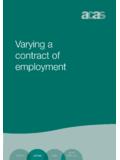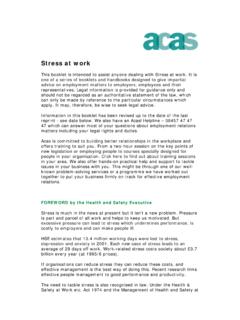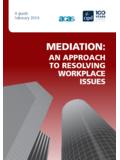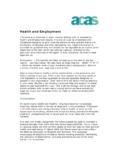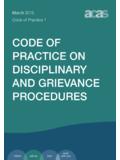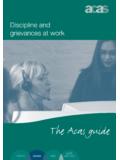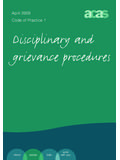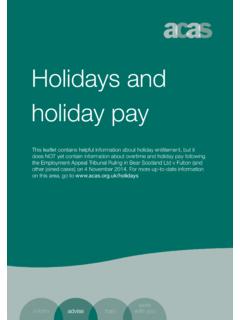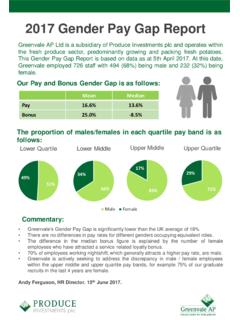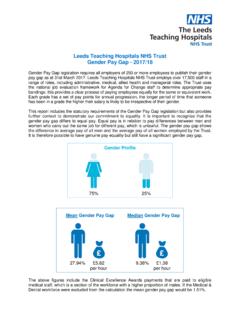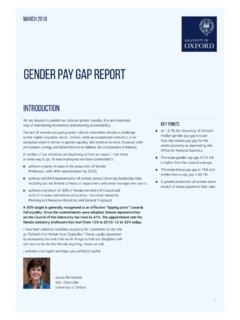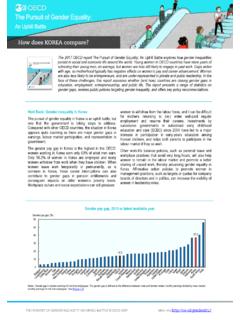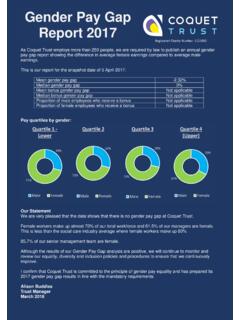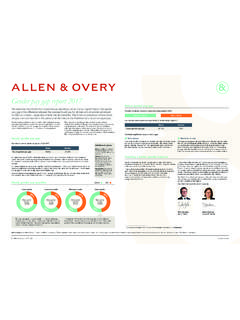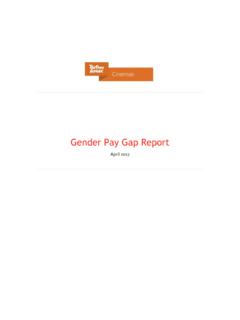Transcription of Guidance Managing gender pay reporting - Home | Acas
1 Guidance Managing gender pay reporting December 2017 Managing gender pay reporting 2 About Acas What we do Acas provides information, advice, training, conciliation and other services for employers and employees to help prevent or resolve workplace problems. Go to for more details. About GEO What we do The Government Equalities Office (GEO) is responsible for equality strategy and legislation across government. We take action on the government s commitment to remove barriers to equality and help to build a fairer society, leading on issues relating to women, sexual orientation and transgender equality. Go to for more details. Must and should Throughout the guide, a legal requirement is indicated by the word must - for example, an employer must base their pay reports on their pay situation in April each year. The word should indicates what Acas considers to be good employment practice.
2 Understanding the term employee For the purposes of gender pay reporting , the definition of who counts as an employee is defined in The Equality Act 2010. This is known as an extended definition which includes: employees (those with a contract of employment) workers and agency workers (those with a contract to do work or provide services) some self-employed people (where they have to personally perform the work) This is covered in more detail in the section Do the regulations apply to my organisation? . December 2017 Information in this guide has been revised up to the date of publication. For more information, go to the Acas website at Legal information is provided for Guidance only and should not be regarded as an authoritative statement of the law, which can only be made by reference to the particular circumstances which apply. It may, therefore, be wise to seek legal advice. Managing gender pay reporting 3 Contents About this guide.
3 4 The gender pay gap and how workplaces contribute to it .. 4 The difference between the gender pay gap and equal pay .. 5 Do the regulations apply to my organisation? .. 5 How do I work out if I have 250 or more employees? .. 6 What happens with groups of employers? .. 6 Which of the two sets of regulations apply to me? .. 7 What about overseas workers and international jobs? .. 7 How to carry out gender pay reporting .. 8 What will I have to calculate and publish? .. 8 Information for self-employed calculations .. 9 What if I fail to publish the gender pay report? .. 9 Step 1: Extract the essential information .. 10 Step 2: The calculations .. 11 Step 3: Make a supporting statement and narrative .. 17 Step 4: Publishing gender pay information .. 18 Step 5: Implement plans to manage the gender pay gap .. 19 Understand key terms .. 22 Snapshot date .. 22 Ordinary Pay, pay period and relevant pay period.
4 22 Bonuses, bonus period and relevant bonus period .. 24 Leave .. 26 Relevant employer .. 26 Full-pay relevant employee .. 26 Relevant employee .. 28 Weekly working hours .. 28 Essential considerations reducing the gender pay gap .. 31 Developing the evidence base .. 31 Ensure related policies and practices are up to date .. 32 Train and support line managers .. 32 Manage family-friendly leave successfully .. 33 Make the most of flexible working .. 33 Encourage and review career and talent development .. 34 Minimise any negative impact from pay systems .. 34 Consider taking positive action .. 35 Further information .. 35 Keep up-to-date and stay informed .. 37 Managing gender pay reporting 4 About this guide This guide offers employers, senior managers, line managers, HR personnel and Payroll and Reward professionals an explanation of what the gender pay gap is, and how to report on it in compliance with legislation.
5 It also offers insight into the business benefits of taking effective action to address the challenges identified by analysing and reporting your gap. Employees and employee/trade union representatives will also find the guide useful for a general understanding of this developing area of employment law. The gender pay gap and how workplaces contribute to it The gender pay gap shows the difference between the average (mean or median) earnings of men and women. This is expressed as a percentage of men s earnings women earn 15% less than men. Used to its full potential, gender pay gap reporting is a valuable tool for assessing levels of equality in the workplace, female and male participation, and how effectively talent is being maximised. The gender pay gap varies by occupation, age group and even working patterns. For example: Whilst both public and private sectors need to take action to eliminate the gender pay gap, the gap tends to be higher in industry sectors such as finance, energy and construction sectors and lower in sectors such as public administration, support services and health and social work.
6 Occupations where women are underrepresented typically produce higher pay gaps; these can be significant for senior level occupations such as finance and investment analysts. There is a gender pay gap even before the arrival of a first child. Unequal sharing of care responsibilities contributes to a higher proportion of women taking part-time work, which is generally lower paid. Consequently the gender pay gap widens, particularly for those employees over 40. Where is the evidence? The Office For National Statistics reported that mothers were still providing 74% of total childcare time in 2015. Source: ONS (2016) Changes in the value and division of unpaid care work in the UK: 2000 to 2015 The Institute for Fiscal Studies reported that there is on average, a (pay) gap of over 10% even before the arrival of the first child. But this gap is fairly stable until the child arrives and is small relative to what follows: there is then a gradual but continual rise in the wage gap and by the time the first child is aged 12, women s hourly wages are a third below men s.
7 Source: IFS (2016) The gender Wage Gap Managing gender pay reporting 5 The challenge therefore is to ensure that the gender pay gap among women over 40 is tackled now and ensure that there is no significant cumulative impact on a woman s earning potential during her lifetime as younger cohorts of workers move into their 40s and beyond. The causes of the gender pay gap are varied and overlapping. Some causes originate outside of the workplace, such as stereotypical representations of men and women and standards in careers advice and Guidance for girls. Factors involving the workplace include: fewer women working in certain more highly-paid professions or areas of an organisation such as those involving science, technology, engineering and maths [STEM] unsupportive and rigid corporate cultures lack of well paid part-time/flexible work women remaining less likely to progress to senior levels in an organisation, making up just over a third of managers, directors and senior officials constrained individual choice, unconscious bias and discrimination - women keen to move into senior or managerial roles are sometimes held back by: o a lack of diverse senior female role models; mentoring and or sponsorship; networking opportunities o particular assumptions about mothers not wanting, or not being in a position to accept, promotion.
8 There are plenty of actions an employer can take to tackle and reduce the gender pay gap outlined later in this guide. However, one of the first and most fundamental changes needed in many cases is greater transparency about gender pay difference. This greater transparency increases the likelihood that action will take place. The difference between the gender pay gap and equal pay The gender pay gap differs from equal pay. Equal pay deals with the pay differences between men and women who carry out the same jobs, similar jobs or work of equal value. It is unlawful to pay people unequally because they are a man or a woman. The gender pay gap shows the differences in the average pay between men and women. If a workplace has a particularly high gender pay gap, this can indicate there may a number of issues to deal with, and the individual calculations may help to identify what those issues are. In some cases, the gender pay gap may include unlawful inequality in pay but this is not necessarily the case.
9 For more information on Equal Pay go Do the regulations apply to my organisation? An employer must comply with the regulations for any year where they have a headcount of 250 or more employees on the snapshot date . Managing gender pay reporting 6 If an employer has fewer than 250 employees on the snapshot date, they are not required to comply with the regulations but should give serious consideration to the business benefits of doing so. How do I work out if I have 250 or more employees? For the purposes of gender pay reporting , the definition of who counts as an employee is defined in the Equality Act 2010. This is known as an extended definition which includes: employees (those with a contract of employment) workers and agency workers (those with a contract to do work or provide services) some self-employed people (where they have to personally perform the work) Agency workers will form part of the headcount of the agency that provides them, and not the employer they are on assignment to.
10 Similarly any individual who is employed by their own service company, which, in turn, contracts to provide a service to an employer would be caught by the headcount of employees for the service company if it employs 250 or more employees, not by the end user. What about part-time work and job-sharing? Each part time worker will count as one employee for gender pay reporting purposes. If an employer uses job-share arrangements then every employee within a job-share counts as one employee each. So, if two people job-share, they would still count as two employees for gender pay reporting purposes. This is particularly important for employers to be aware of if they are accustomed to handling employee numbers as full time equivalents because the obligation to report and the calculations that follow are based on the number of individual employees. What about partners? Partners, where they would usually also be considered employees, should be used to establish the employee headcount but not be used as part of the calculations.

